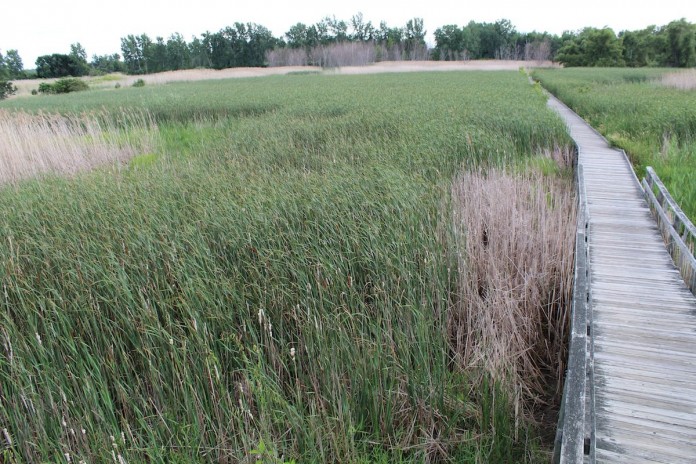I sat in on a very interesting presentation during our Conservation Partnership Conference this February in Columbus.
Ohio River algae
It was titled “It’s Toxic and not just in Lake Erie” and was about the toxic algae bloom in the Ohio River late last summer. I’ll admit that I wasn’t too excited about the presentation.
I had heard bits and pieces about the bloom but it was nothing like the coverage that Lake Erie and the Maumee River watershed was getting. I assumed that the bloom started around Wheeling and drifted down around Cincinnati before dispersing.
No conversations
I really didn’t think that it was a huge deal, and I hadn’t heard anyone in our circles talking about it. But when Greg Youngstrom began his presentation I began to get a bad feeling that I should have paid more attention to this event.
Expert testimony
Youngstrom is an environmental scientist for The Ohio River Sanitation Commission (ORSANCO) and works out of the Cincinnati office.
ORSANCO is responsible for the control and abatement of pollution in the Ohio River watershed, and they represent 8 states as well as the federal government.
Wheeling bloom. Youngstrom informed us that the bloom did indeed start near Wheeling, but did not move as I had thought, it continued blooming for nearly 650 river miles!
Now Youngstrom had my attention.
Little flow
He informed us that because of all of the locks that allow shipping barges to traverse the Ohio there is not much flow to the river. In fact, some of the pools flow so slowly that they are just over the threshold of being considered a reservoir.
Little rainfall
Combine this with the fact that there was very little rain from August through October and the Ohio River essentially turned into a big lake. ORSANCO began to sample and monitor the river looking for the same elevated microcystin levels that caused the Toledo water crisis.
No swimming
Although people were told to avoid swimming in the water, there were no instances where towns that use the river for drinking water deemed that the water was unsafe to drink.
Eventually, colder weather caused the algae bloom to shrink and disappear in late October.
No cause determined
Youngstrom said that ORSANCO was still looking into what caused the bloom, but that the conditions were ideal for the bloom to start and grow. I walked out of that seminar with a not so good feeling.
How was this not national news? Why weren’t more people in the Ohio River basin talking about this?
Drinking water
Likely because no one was told that they couldn’t drink the water. Ohio narrowly avoided having two black eyes nationally from the green water on both of our “coasts.” The next thought that I had didn’t make me feel any better: How long until Senate Bill 1 encompasses the entire state?
Regulation
We can no longer think that just because our runoff does not enter the western basin of Lake Erie that we are safe from regulation. It is time to think proactively as an agricultural community in southern and eastern Ohio so that we can be as prepared as possible if and when regulation on nutrients comes.
The first thing to do is to soil test.
Soil test
No one can guess what the pH and nutrient levels are in the soils on their farm. A soil test will give this information and then recommendations can be made on what nutrients are needed and how much. This not only keeps us from over applying nutrients but from spending money that will not give a return on investment.
Every little bit helps in this time of low commodity and livestock prices.
Manure samples
Another idea is to send in a manure sample before hauling to find out the nutrient content it contains. I am always surprised when people act like manure is just waste that needs to be disposed of. There is value to manure, both in nutrient content and returning organic material to the soil.
By testing manure, we can use it exactly like synthetic fertilizer, applying enough to satisfy the nutrient recommendation for the upcoming crop based on soil testing. Synthetic fertilizer. Speaking of applying synthetic fertilizer and manure, there are guidelines to follow in that area as well.
Producers should make every effort to not apply manure or fertilizer on frozen or snow-covered ground. If a producer has no other choice the best place to apply is on a growing crop; either a hay field, winter wheat field, or a cover crop field.
Application methods
Also, think about different application methods, such as injecting or subsurface banding. These methods can reduce the risk of runoff by placing the nutrient underground where it is less likely to be carried away by heavy rains.
Underground placement can also allow phosphorous molecules a chance to bind with the soil reducing the potential for loss.
Don’t try to beat the rain
Also, don’t try to beat the rain when hauling manure or spreading fertilizer. It is now against the law to spread fertilizer if there is a fifty percent chance of a one-inch rain event in a 12-hour period in Northwest Ohio.
It is also against the law to spread manure if there is a fifty percent chance of one-half inch of rain in a 24-hour period. The only exceptions to this law are if the producer injects or bands the nutrients, incorporates them with tillage, or applies them to a growing crop.
It is a good idea to start thinking about this now, even though those of us in southern and eastern Ohio currently are not held to that law.
State regulation
We will also need to protect ourselves if regulation ever does encompass the whole state. This means keeping detailed records of ALL fertilizer and manure applications.
Keeping records
Where, when, what was applied, how much was applied, weather conditions that day, weather forecast for the next 2 days, and any other information that the producer may think is relevant should all be recorded and saved. This would be an excellent habit to get into.
Defense
If regulation comes, then accurate records will be the first line of defense for anyone accused of wrongdoing.
Also, a Comprehensive Nutrient Management Plan, or Nutrient Management Plan, if only synthetic fertilizer is used, can help protect producers. Contact your local SWCD for assistance with either of these documents.
Think about the future
It is not my intention to scare anyone into changing the way they manage nutrients on their farm with this article. I am only trying to get producers to think about changes that could be coming in the years ahead.
Like it or not, we will all be under a microscope if large-scale algae blooms continue in the Ohio River. By making small changes now we as farmers can hopefully be more prepared if the laws of Senate Bill 1 grow to include the entire state of Ohio.
While most of us wish we had a crystal ball to see exactly what changes the future will bring, we will never have that luxury.
Be aware
It is better to be aware of current events and to think about how they may affect the way we farm in the future. I think I will start by paying much closer attention to any potentially impactful story in the Ohio River Basin.













